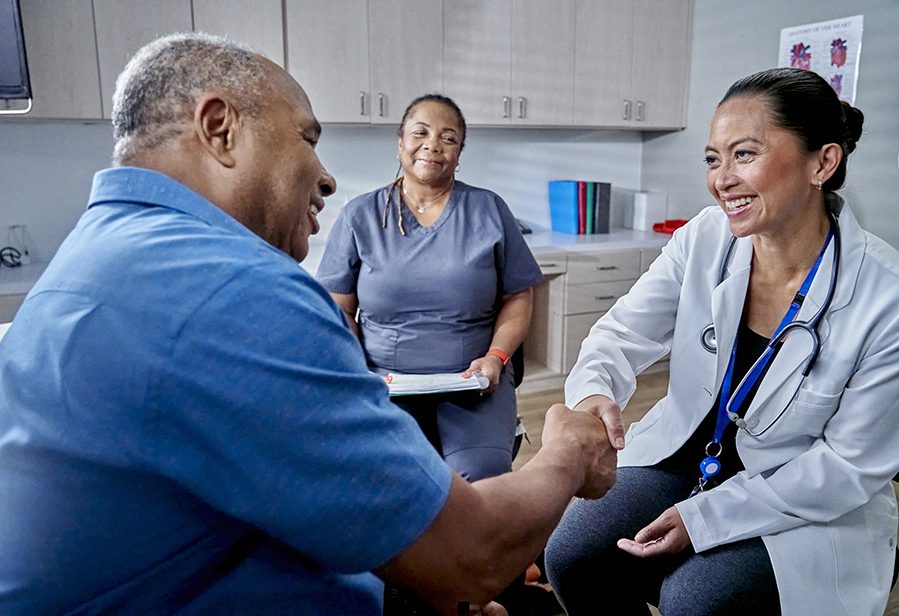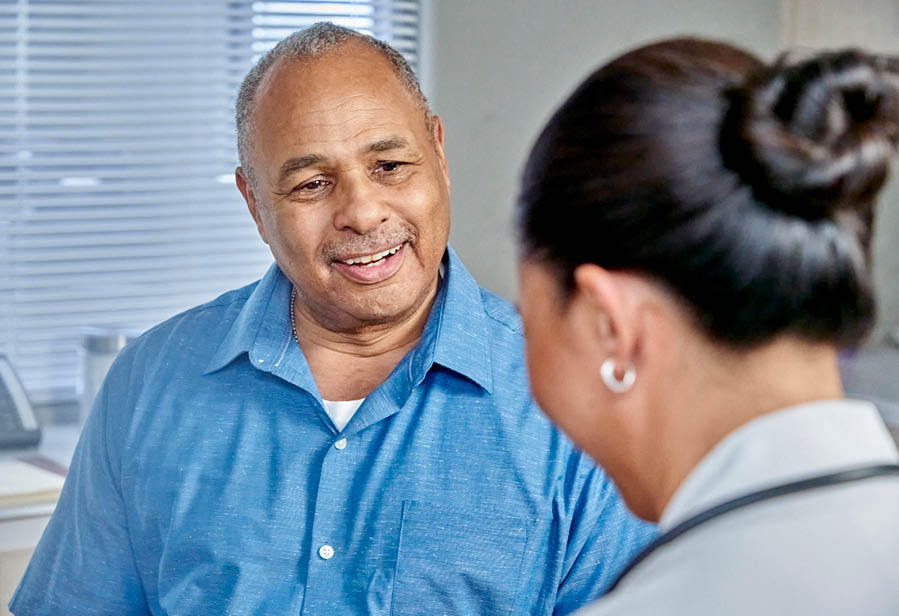Diabetes is a dangerous, chronic disease that affects how your body manages blood sugar and energy. It occurs when your pancreas limits or stops producing insulin, which results in dangerously high blood sugar.

There are two kinds of diabetes: Type 1 and Type 2. While they have similarities, they’re not the same.
What is Type 1 diabetes?
Type 1 diabetes occurs when the body’s immune system mistakes healthy insulin-producing cells in the pancreas for invasive entities and destroys them. This prevents the pancreas from producing any insulin at all, resulting in dangerously high blood sugar levels. Though it typically begins in childhood, it can occur at any age.
Unfortunately, while the causes of Type 2 diabetes are typically affected by lifestyle, medical experts are still trying to understand the cause of Type 1 diabetes.
What are the signs and symptoms of Type 1 diabetes?
While symptoms of Type 2 diabetes may take years to progress, symptoms of Type 1 usually occur within weeks of its onset.
These may include:
- Excessive thirst
- Frequent urination
- Fatigue
- Unexplained and dramatic weight loss
- Blurry vision
If you or a loved one is experiencing any of these symptoms, don’t hesitate to see your doctor for diagnosis!
How is Type 1 diabetes diagnosed?
To test for Type 1 diabetes, your doctor will perform some blood tests that include an A1C screening, or glycated hemoglobin test. This will measure your average blood sugar levels from the past two to three months, with higher levels indicating you have either of the 2 types of diabetes.
For instance, an A1C level of more than 6.5% indicates the onset of diabetes.
What are the treatments for Type 1 diabetes?
Unfortunately, there is no known cure for Type 1 diabetes, which can only be managed. Since it prevents the body from producing any insulin, either regular insulin shots must be administered or an insulin pump that produces a steady supply may be used.
Your doctor will also perform regular blood testing to monitor blood sugar levels, which can rise and fall rapidly and require adjustments to be made.
Management should also include keeping your blood sugar in check through a healthy lifestyle. This includes eating a balanced diet, avoiding sugar and staying active.
What is Type 2 diabetes?
While Type 1 diabetes affects around 8% of diabetes sufferers, Type 2 affects over 90%, making it, by far, the predominant type. It’s also different from Type 1 in that its causes are known and its onset is progressive, rather than sudden. For this reason, symptoms of Type 2 diabetes appear more slowly than with Type 1 and may not be noticeable at first.
Type 2 diabetes can be avoided—and in its early stages, possibly reversed—with a healthy diet that limits sugar and includes regular exercise and by maintaining a healthy weight.
It also shares many of Type 1 diabetes’ symptoms as the disease progresses.
These include:
- Excessive hunger and thirst
- Frequent urination
- Fatigue and blurry vision
- Tingling and numbness in the hands and feet
- Itchy skin
But mostly, Type 2 diabetes is caused by risk factors leading to insulin resistance. These include being overweight, inactive and adhering do a poor diet. Genetics may also play a role.
How is Type 2 diabetes diagnosed?
According to the Centers for Disease Control and Prevention, as of 2018, over 34 million people in the U.S. live with undiagnosed diabetes. The percentage of diabetes sufferers also increases with age, with more than 26% of those over age 65 having the disease, despite it affecting around 10.5% of the U.S. population.
It is, therefore, important for older people—and especially those at elevated lifestyle risk—to visit their doctor for diabetes testing. As with Type 1 diabetes, this will involve an A1C blood test, either through drawn blood or a finger prick. If your A1C levels are 6.5% or higher over the previous two to three months, it indicates diabetes.
What are the risk factors, prevention and management options of Type 2 diabetes?
Since the same risk factors that cause Type 2 diabetes can also worsen it, it’s important that you understand them, especially early in your diagnosis, when your condition may possibly be reversed. This is unlike Type 1 diabetes, which can’t be reversed.
But risk factors for Type 2 diabetes include:
- Being overweight, especially belly fat
- Being inactive and avoiding exercise
- Being older
- Having elevated blood sugar levels, or prediabetes
- Have had gestational diabetes, or diabetes from pregnancy
- Have a family history of diabetes
- Are of Native American, Hispanic or African descent
- Have had polycystic ovary syndrome, or PCOS
But since its risk factors are mostly controllable by you, it’s also possible to prevent Type 2 diabetes in the first place. This means avoiding sugary, starchy foods; reducing stress; and getting enough exercise.
Having trouble maintaining a healthy weight or knowing how much exercise you need? Talk to your doctor, who will be happy to help set up a plan for you to safely and effectively avoid the dangers of Type 2 diabetes.
When should you see your doctor?
For Type 1 diabetes, there is a life-threatening condition called ketoacidosis that stems from your body being so starved for energy that it starts breaking down fats. Though this may sound like a good thing, it isn’t, since the same process produces toxic acids known as ketones.
Unfortunately, ketones can cause such dangerous symptoms as:
- Nausea
- Vomiting
- Chest pains
- Abdominal pains
Ultimately, this can lead to a coma, and to say the least, if you or a loved one is experiencing any of these symptoms SEEK MEDICAL ATTENTION IMMEDIATELY!
For both types of diabetes, low blood sugar, aka hypoglycemia caused by using too much insulin, can be a dangerous problem.
Symptoms of low blood sugar include:
- Fatigue
- Paleness
- Shakiness
- Anxiety
- Irritability
- Tingling or numbness of the mouth regions
- An irregular and/or rapid heart rate
- Perspirating
Hypoglycemia needs immediate attention, which usually means consuming foods high in sugar, or having a sweet drink, such as juice. Glucose tablets may also be used, though the important thing is to get your blood sugar levels back to normal.
Which questions should you ask your physician?
Diabetes is a complex and dangerous condition, and the more information you have about it, the greater your chances of its successful management.
This means asking your doctor questions such as, “What lifestyle changes do I need to make,” or “How will this affect my family?” You may also want to find out about support networks or groups to help keep you motivated to eat right and exercise.
But no matter what questions you have, the important thing is that you ask them. Not only is there no such thing as a stupid question, but your Intermountain Health physician will also respond to ALL your questions with careful, thorough and compassionate answers.
Again, the important thing is that you ask all the questions you can think of, since when it comes to diabetes Type 1 or 2, you can never be too informed.
Why should you choose a provider at Intermountain Health?
Being diagnosed with Type 1 or Type 2 diabetes is a frightening experience, which is why you need not only the accuracy of state-of-the-art healthcare, but also the compassion and understanding to go along with it. At Intermountain Health, we’re here to serve you with both, and then some.
That’s because our focus is on providing you and your community with exceptional, personalized care that strives to go above and beyond expectations. We empower you to live your healthiest life possible and to do so in a way that’s more like visiting a friendly neighbor than a healthcare provider.
At Intermountain Health, it’s you we’re here to serve, and that’s our promise each and every time you visit.
*This article is for informational purposes only and is not intended to be a substitute for medical advice or diagnosis from a physician or qualified healthcare professional.





